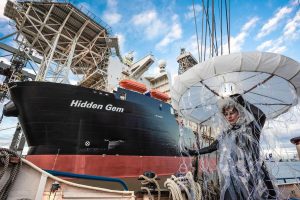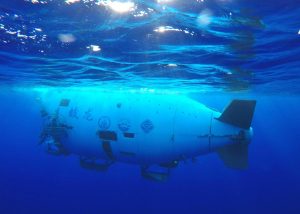With the future of mineral mining on the ocean floor remaining contested and murky, Dialogue Earth digs into the debates

Patania II is a prototype deep-sea mining machine developed by Belgian company GSR to collect small nodules. They contain valuable minerals used in technology, such as smartphones and, increasingly, solar panels. (Image © GSR)
Regina Lam, Jessica Aldred
June 20, 2024
The deep sea is an underwater world scientists are still trying to fathom. It is also a reserve of increasingly sought-after minerals that are critical for modern life, making it a site of major competition for resources. Some governments are gearing up to exploit the seabed, while others want such deep-sea mining halted until its risks to marine life and the environment are better understood.
As the debate escalates, Dialogue Earth breaks down what is known about the uncharted waters of deep-sea mining.
In this explainer:
What exactly is deep-sea mining?
What are deep-sea miners after?
How might deep-sea mining affect the ocean?
Is mining already taking place?
What is the International Seabed Authority?
Who wants to mine?
Who is against mining?
Where does China stand?
When could commercial mining start?
What exactly is deep-sea mining?
Mining the deep sea involves extracting mineral deposits from seabeds at more than 200 metres below the surface. This area covers around 65% of the planet and harbours a rich diversity of species, many still unknown to science. It encompasses geological features including mountain ranges, plateaus, volcanic peaks, canyons, vast abyssal plains and chasms including the Mariana Trench, which is home to the deepest point of the ocean, at 11,000 metres.
While commercial mining is still a prospect rather than a reality, experimental deep-sea mining has already taken place. The process usually involves deploying seafloor vehicles to dredge or sever seabed formations and scooping or suctioning up mineral-rich deposits to a support vessel, where they can be stored, processed and transported to shore.

(Source: The Pew Charitable Trusts & New Zealand Environment Guide. Graphic: Ed Harrison / Dialogue Earth)
What are deep-sea miners after?
Would-be miners are targeting nickel, copper, cobalt, manganese, zinc, silver and gold. These are so-called “critical minerals” – metals essential to modern technology and widely used in the manufacture of smartphones, laptops, solar panels, wind turbines and electric vehicles. Attention is focused on three types of marine mineral deposits: polymetallic nodules found lying on the seafloor; polymetallic sulphides known as “seafloor massive sulphide deposits” that form around active, high-temperature hydrothermal vents; and cobalt-rich ferromanganese crusts that cover underwater mountains known as seamounts.

Graphic: Ed Harrison / Dialogue Earth
Advocates argue that the deep sea could be a reliable, clean and ethical alternative to terrestrial sources. Opponents have environmental concerns and say projections of the need for deep-sea minerals may be wildly optimistic, and that demand can be met by known terrestrial resources and more advanced recycling of metals.
How might deep-sea mining affect the ocean?
Scraping the ocean floor to extract resources could destroy deep-sea homes of octopuses, sponges and other species. Mining hydrothermal vents would require removing entire vent structures, which can support thriving animal communities. Exploiting cobalt-rich crusts deposited on seamounts would potentially remove fauna found there and on the seafloor, which could do similar or even more damage to bottom trawling.
Secondary impacts are also possible. Mining would produce sediment plumes, some of which could be toxic and smother animals downstream. Noise and light pollution caused by mining could disrupt deep-sea communities uniquely adapted to high pressures and the lack of sunlight. Deep-sea animal communities are often slow growing and could take decades – even centuries – to recover from disturbance.
Is mining already taking place?
Shallow-water mining for sand, tin and diamonds is already happening around the world. Some deep-sea mining exploration has taken place to scope for mining potential and test equipment, both within areas under national control and in international waters. But mining has yet to be conducted commercially.
Countries have the rights to explore and exploit the natural resources of the seabed and subsoil within their territorial sea and exclusive economic zone (EEZ), which normally extends 200 nautical miles beyond a nation’s territorial sea. Nations can claim rights over even more seabed on the continental shelf under certain circumstances. Norway and the Cook Islands are among the nations actively pursuing mining in the waters under their control.
As for seabeds beyond national jurisdiction, the UN stipulates that they belong to no individual nation and are the “common heritage of mankind”; any activities carried out there must therefore be for “the benefit of mankind”. Full-scale mining in these areas cannot begin until the International Seabed Authority signs off a binding code on how it should be conducted.
What is the International Seabed Authority?
The International Seabed Authority (ISA) is an intergovernmental organisation based in Kingston, Jamaica, that has been tasked with developing a code to regulate the exploitation of minerals in international waters. It was established under the UN Convention on the Law of the Sea and counts all 168 signatories as member states, including the EU.
To date, it has issued 31 contracts for mining exploration in high seas areas totalling more than 1 million square kilometres. Over half of the exploration contracts are for polymetallic nodules in the area between Hawaii, Kiribati, and Mexico in the Pacific Ocean, known as the Clarion-Clipperton Zone (CCZ).
The ISA has since 2014 been working on a code for deep sea mining, and some nations and businesses are putting increasing pressure on the body to finalise these regulations. In 2021, the small Pacific island state of Nauru invoked a never-before-used ISA rule that compels the authority to allow mining to proceed within two years under whatever regulations are in place at the time. The regulations were still far from complete when the two-year rule expired.
Any exploitation license applications submitted under the two-year rule still have to be approved by the ISA, and it is very unlikely this will happen before the regulations are finalised. During the regulator’s meeting in July 2023, delegates agreed to a non-legal binding target of working “with a view” to completing the rules by July 2025.
Any exploitation license applications submitted under the two-year rule still have to be approved by the ISA, and it is very unlikely this will happen before the regulations are finalised. During the regulator’s meeting in July 2023, delegates agreed to a non-legal binding target of working “with a view” to completing the rules by July 2025.
Who wants to mine?
The list of would-be deep-sea miners includes private businesses, state-owned companies and governments, including those of China, India, Japan, Russia and South Korea. Some nations have teamed up: the Interoceanmetal Joint Organization is a consortium formed of Bulgaria, Cuba, the Czech Republic, Poland, Russia and Slovakia. Small island states which control significant amounts of seabed are also keen to engage in mining, including the Cook Islands, Kiribati, Nauru, Singapore and Tonga.

RECOMMENDEDIn Latin America, resistance to deep-sea mining is growing
Some nations are further ahead than others. The Cook Islands has already offered licences to three companies to study the feasibility of mining seabed minerals in its territorial waters. Norway’s parliament decided to open its extended continental shelf for deep-sea mining exploration earlier this year (this area goes beyond its territorial waters but falls under Norwegian control due to UN rules). The government says any extraction plans require approval from the energy ministry and the parliament, and only “sustainable and responsible” projects will be permitted.
Who is against mining?
An increasing number of nations are cautioning against starting commercial deep-sea mining without a better understanding of its impacts. To date, 25 countries have called for pauses or a full ban, including Brazil, Canada, Denmark, France, Fiji, Germany, Mexico and the UK.
Scientists concerned about potentially irreparable damage to ecosystems say not enough is known about deep-sea species and ecosystems to establish an adequate baseline against which to protect them or monitor the impact of mining. Conflicts between mining and other ocean activities could also occur as proposed mining areas overlap with shipping routes, fishing grounds, and areas bio-prospected for genetic resources. The increase in marine traffic and mining waste discharge could disrupt the primary productivity of the food web (the rate at which energy is converted to organic substances by organisms), and potentially affect fish populations.
Major companies, including Google, Samsung, Patagonia, BMW, Volvo and Volkswagen Group, have backed a call from the WWF for a temporary ban. These companies have pledged to ensure minerals extracted from the deep sea are not used in their products.

A sea star 2,500 meters beneath the central Pacific Ocean turns its stomach inside out to feed on Victorgorgia coral (Image: NOAA)
Where does China stand?
China holds five out of the 31 ISA exploration contracts, the most of any country. Several of its national research institutions, universities and state-owned companies have built up their technical capability for deep-sea exploitation, in part as a hedge against high reliance on imported strategic minerals. Recently, Qingdao and Shanghai’s municipal governments have also begun exploring opportunities to boost related research.
In 2016, the country adopted a Deep Sea Law to set regulations for deep-sea exploration and exploitation activities, including licensing, environmental impact assessments and monitoring requirements. China’s representatives at the ISA have been actively engaged in the mining regulation negotiations, pushing back on a discussion of a moratorium on mining during the ISA talks in July 2023. Beijing said the ISA was established to regulate seabed activities by setting out rules for mineral exploitation and protecting the deep sea environment
.
RECOMMENDEDHow will China’s submersibles help us explore the ocean depths?
Some marine engineering researchers suggest more effort and investment is needed from the nation for it to catch up with progress in technological and equipment development achieved by Europe, Japan and South Korea.

RECOMMENDEDHow will China’s submersibles help us explore the ocean depths?
Some marine engineering researchers suggest more effort and investment is needed from the nation for it to catch up with progress in technological and equipment development achieved by Europe, Japan and South Korea.
When could commercial mining start?
For mining rights in international waters to be granted, contractors will have to conduct environmental impact assessments in line with ISA rules. They also need to demonstrate financial and technological capacity to actually undertake proposed mining activities. Nauru’s invocation of the ISA law means that contractors can now apply for mining licenses. But applications are unlikely to be approved by the authority before it finalises the rules, regulations and procedures. Member nations have agreed to work towards adopting the rules by July 2025, but many representatives have expressed doubt that the body will be able to meet a non-binding timeline.
To date, no party has submitted a mining licence to the ISA. But Nauru could be the first to start commercial exploitation. It is a sponsoring state for Nauru Ocean Resources Inc (NORI), a wholly owned subsidiary of The Metals Company. The company, based in Canada, says NORI intends to apply for an exploitation contract following the next ISA meeting in July 2024, and expects to be in production in late 2025.
This is an updated version of the explainer, which was first published in February 2019 and last updated in November 2021.

Regina Lam is an ocean and special projects assistant editor at Dialogue Earth, based in London. She joined in 2021 and has worked at major Hong Kong newspapers and has reported for the BBC World Service. She holds an MSc in global affairs from King’s College London. Regina is interested in global ocean governance, environmental justice and what makes compelling storytelling and robust investigation in environmental journalism. She speaks Cantonese, Mandarin and English.

Jessica Aldred is former special projects (oceans) editor at Dialogue Earth
No comments:
Post a Comment